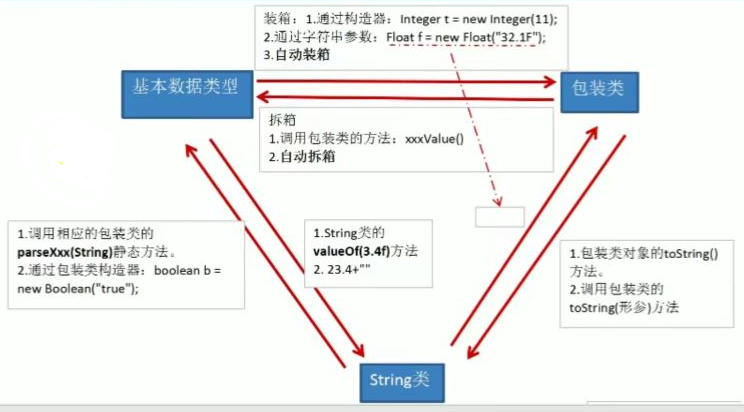针对八种基本数据类型定义相应的引用类型--包装类(封装类)
有了类的特点,就可以调用类中的方法,Java才是真正的面向对象
| 基本数据类型 | 包装类 |
|---|---|
| byte | Byte |
| short | Short |
| int | Integer |
| long | Long |
| float | Float |
| double | Double |
| boolean | Boolean |
| char | Character |
Byte, Short, Integer, Long, Float, Double 父类是 Number
基本数据类型包装成包装类的实例 ---装箱
- 通过包装类的构造器实现:
int i = 500; Integer t = new Integer(i);
- 还可以通过字符串参数构造包装类对象:
Float f = new Float("4.56");
Long l = new Long("asdf"); //NumberFormatException
获得包装类对象中包装的基本类型变量 ---拆箱
- 调用包装类的 .xxxValue() 方法:
boolean b = bObj.booleanValue();
JDK1.5之后,支持自动装箱,自动拆箱。但类型必须匹配。
基本类型,包装类与 String 类间的转换

举例
WrapperTest.java
package com.klvchen.java2;
import org.junit.jupiter.api.Test;
public class WrapperTest {
//String 类型 ---> 基本数据类型,包装类
@Test
public void test5() {
String str1 = "123";
//错误情况
// int num1 = (int)str1;
// Integer in1 = (Integer)str1;
//可能会报 NumberFormatException
int num2 = Integer.parseInt(str1);
System.out.println(num2 + 1); //124
String str2 = "true1";
boolean b1 = Boolean.parseBoolean(str2);
System.out.println(b1); //false
}
//基本数据类型,包装类 ---> String 类型
@Test
public void test4() {
int num1 = 10;
//方式1: 连接运算
String str1 = num1 + "";
//方式2: 调用 String 的 valueOf(XXX xxx)
float f1 = 12.3f;
String str2 = String.valueOf(f1);
System.out.println(str2); //12.3
Double d1 = new Double(12.4);
String str3 = String.valueOf(d1);
System.out.println(str3); //12.4
}
//基本数据类型 ---> 包装类的对象(JDK 5.0 的特性,自动装箱与自动拆箱)
@Test
public void test3() {
// int num1 = 10;
// method(num1);
//自动装箱:基本数据类型 ---> 包装类
int num2 = 10;
Integer in1 = num2; //自动装箱
boolean b1 = true;
Boolean b2 = b1; //自动装箱
//自动拆箱: 包装类 ---> 基本数据类型
System.out.println(in1.toString()); //10
int num3 = in1; //自动拆箱
}
public void method(Object obj) {
System.out.println(obj);
}
//包装类 ---> 基本数据类型:调用包装类的 xxxValue()
@Test
public void test2() {
Integer in1 = new Integer(12);
int i1 = in1.intValue();
System.out.println(i1 + 1); //13
Float f1 = new Float(12.3);
float f2 = f1.floatValue();
System.out.println(f2 + 1); //13.3
}
//基本数据类型 ---> 包装类
@Test
public void test1() {
int num1 = 10;
// System.out.println(num1.toString()); //基本数据类型,无法调用方法
Integer in1 = new Integer(num1);
System.out.println(in1.toString()); //10
Integer in2 = new Integer("123");
System.out.println(in2.toString()); //123
//报异常 java.lang.NumberFormatException
// Integer in3 = new Integer("123abc");
// System.out.println(in3.toString());
Float f1 = new Float(12.3f);
Float f2 = new Float("12.3");
System.out.println(f1); //12.3
System.out.println(f2); //12.3
Boolean b1 = new Boolean(true);
Boolean b2 = new Boolean("true");
System.out.println(b1); //true
System.out.println(b2); //true
Boolean b3 = new Boolean("true123");
System.out.println(b3); //false
Order order = new Order();
System.out.println(order.isMale); //false
System.out.println(order.isFemale); //null
}
}
class Order{
boolean isMale;
Boolean isFemale;
}
总结
基本数据类型 ---> 包装类
自动装箱:
eg: int num2 = 10;
Integer in1 = num2;
包装类 ---> 基本数据类型
自动拆箱:
eg: Integer in1 = new Integer(12);
int num2 = in1;
基本数据类型,包装类 ---> String 类型
调用 String 的 valueOf(XXX xxx)
eg: float f1 = 12.3f;
String str2 = String.valueOf(f1);
String 类型 ---> 基本数据类型,包装类
调用对应方法的包装类的 parseXxx(Sting)
eg: String str1 = "123";
int num2 = Integer.parseInt(str1);